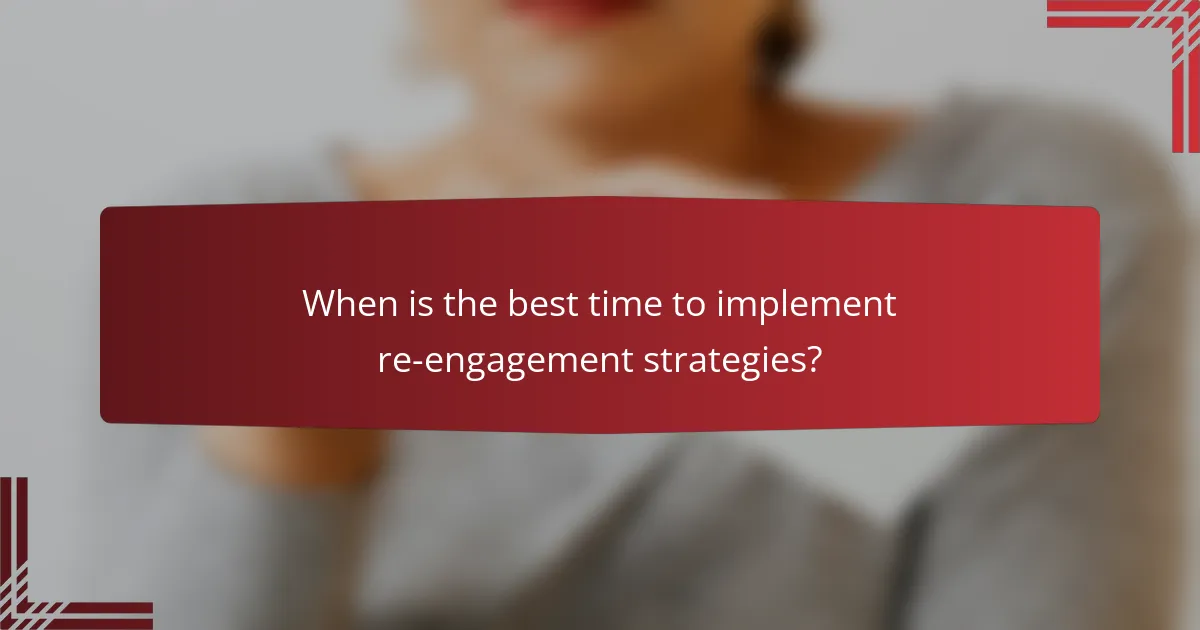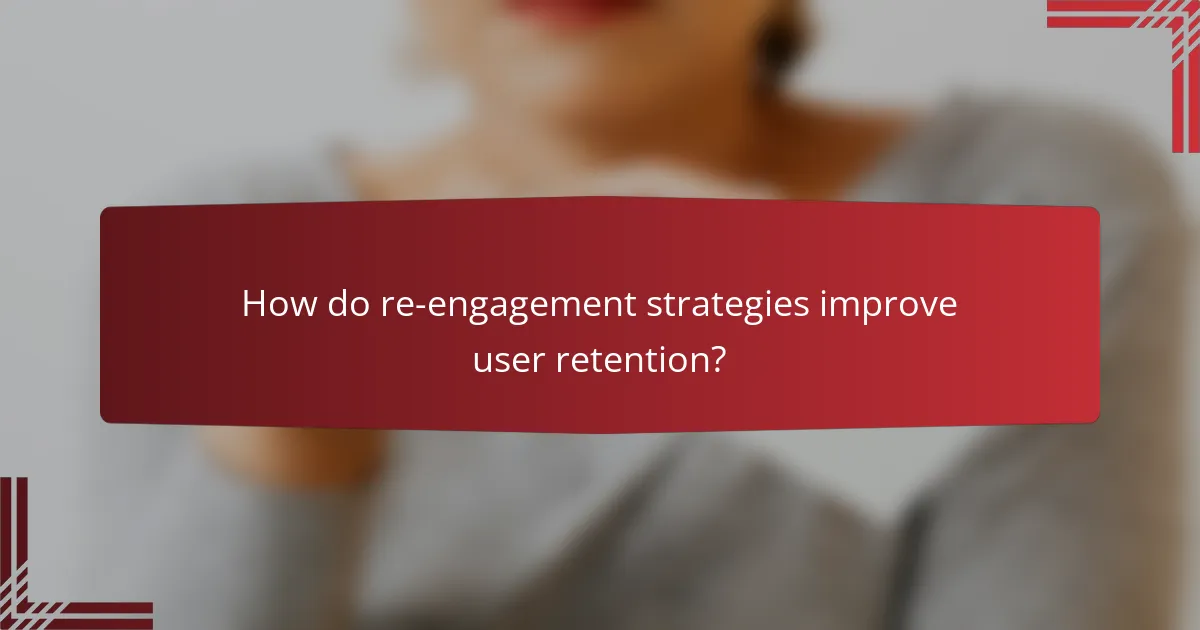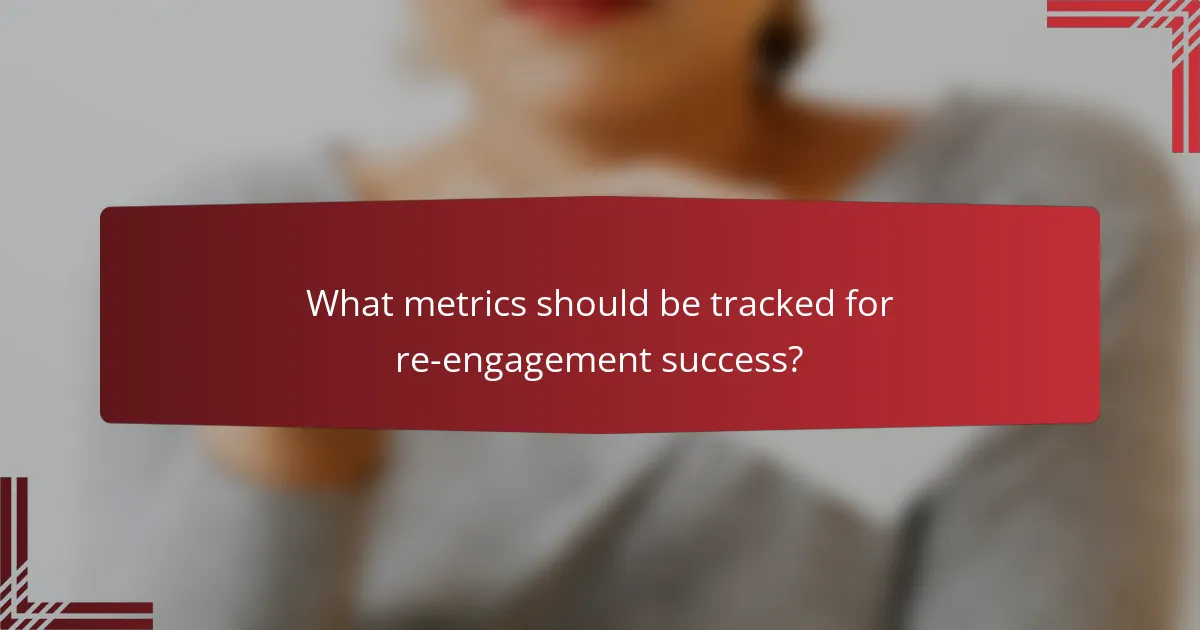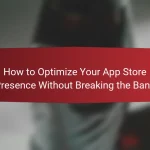Re-engagement strategies are essential for enhancing user retention by reigniting interest and motivating users to return to your platform. By utilizing personalized communication, timely interactions, and attractive incentives, these techniques create meaningful connections that foster loyalty. Implementing these strategies during periods of user inactivity or special promotions can significantly boost engagement and overall user experience.

What are effective re-engagement strategies for user retention?
Effective re-engagement strategies for user retention focus on rekindling interest and encouraging users to return to your platform. These methods leverage personalized communication, incentives, and timely interactions to enhance user experience and loyalty.
Email marketing campaigns
Email marketing campaigns are a powerful tool for re-engaging users. By sending targeted emails that highlight new features, updates, or personalized content, businesses can remind users of the value they provide. Timing is crucial; consider sending emails during peak engagement times or after a period of inactivity.
To maximize effectiveness, segment your audience based on behavior and preferences. This allows for tailored messaging that resonates with specific user groups, increasing the likelihood of re-engagement. A/B testing different subject lines and content can also help refine your approach.
Personalized content recommendations
Personalized content recommendations enhance user experience by suggesting relevant products or articles based on previous interactions. Utilizing algorithms that analyze user behavior can help in curating these recommendations, making them more appealing and relevant.
Implementing a recommendation engine can significantly improve user retention. For instance, platforms like Netflix and Amazon use this strategy to keep users engaged by showcasing content that aligns with their interests. Regularly updating these recommendations based on user activity is essential for maintaining relevance.
Incentive programs
Incentive programs, such as loyalty rewards or discounts, can effectively encourage users to return. Offering tangible benefits, like exclusive access or monetary discounts, motivates users to engage with your platform again.
Consider creating tiered rewards systems that provide increasing benefits based on user activity levels. This not only incentivizes re-engagement but also fosters long-term loyalty. Ensure that the incentives are clearly communicated and easy to redeem to avoid user frustration.
Social media engagement
Engaging users through social media can reignite interest and foster community. Regularly posting updates, interactive content, and user-generated content encourages users to interact with your brand outside of your primary platform.
Utilize social media analytics to understand which types of content resonate most with your audience. Hosting contests or live Q&A sessions can also boost engagement and provide users with a reason to return and participate actively.
Push notifications
Push notifications serve as timely reminders that can bring users back to your app or website. By sending personalized, relevant notifications based on user behavior, you can effectively prompt re-engagement.
Be mindful of frequency and content; overly frequent notifications can lead to user annoyance and opt-outs. Aim for a balance that keeps users informed without overwhelming them. Testing different messaging strategies can help identify what drives the best response rates.

When is the best time to implement re-engagement strategies?
The optimal time to implement re-engagement strategies is typically after a user has shown signs of inactivity, during seasonal promotions, or following a purchase. These moments present unique opportunities to reconnect with users and encourage them to return to your platform.
After user inactivity
Re-engagement efforts should be initiated after a user has been inactive for a specific period, often ranging from a few weeks to a couple of months. This timeframe allows you to identify users who may have lost interest and need a nudge to return.
Consider sending personalized emails or notifications that highlight new features, content, or exclusive offers tailored to their previous interactions. A gentle reminder can reignite their interest and encourage them to re-engage with your platform.
Seasonal promotions
Seasonal promotions are ideal for re-engagement as they leverage the urgency and excitement of limited-time offers. Timing your campaigns around holidays or special events can attract users back to your platform, especially if you provide exclusive deals or discounts.
For instance, a retail website might offer a special discount during the holiday season to entice past customers. Ensure that your messaging is clear and emphasizes the benefits of returning during these promotional periods.
Post-purchase follow-ups
Following up with users after a purchase is crucial for maintaining engagement and encouraging repeat business. This can be done through thank-you emails, feedback requests, or recommendations for related products.
Consider implementing a structured follow-up schedule, such as sending a thank-you message within a few days of purchase, followed by personalized suggestions a week later. This approach not only enhances user experience but also fosters loyalty and increases the likelihood of future purchases.

How do re-engagement strategies improve user retention?
Re-engagement strategies enhance user retention by rekindling interest and encouraging users to return to a product or service. These strategies often involve targeted communication and personalized experiences that cater to user preferences and behaviors.
Increased user loyalty
Implementing effective re-engagement strategies can significantly boost user loyalty. By reaching out to inactive users with tailored messages or offers, businesses can remind them of the value they provide, fostering a sense of connection and commitment.
For example, a subscription service might send a personalized email with a special discount to users who haven’t logged in for a month. This approach not only incentivizes return visits but also reinforces the relationship between the user and the brand.
Higher conversion rates
Re-engagement strategies can lead to higher conversion rates by targeting users who have previously shown interest but have not completed a desired action, such as making a purchase. By reminding these users of their interest, businesses can effectively guide them back to the conversion funnel.
For instance, an e-commerce site might send reminders about items left in a shopping cart, often resulting in a conversion rate increase of 10-20%. This tactic capitalizes on the user’s prior intent, making it easier to convert them into paying customers.
Enhanced user experience
Re-engagement strategies contribute to an enhanced user experience by providing relevant content and personalized interactions. When users receive communications that resonate with their interests, they are more likely to feel valued and understood, leading to a positive perception of the brand.
Consider a mobile app that uses push notifications to inform users about new features based on their usage patterns. This not only keeps users informed but also encourages them to explore the app further, improving overall satisfaction and retention.

What metrics should be tracked for re-engagement success?
To measure re-engagement success, focus on key metrics that indicate user interaction and retention. Tracking open rates, click-through rates, and user activity levels provides valuable insights into how effectively your strategies are working.
Open rates
Open rates reflect the percentage of users who open your emails or notifications, serving as a primary indicator of interest. A good open rate typically ranges from 15% to 30%, depending on the industry and audience. To improve this metric, consider optimizing subject lines and sending times to match user preferences.
Regularly analyze open rates to identify trends or changes in user behavior. If you notice a decline, it may be time to refresh your content or segment your audience for more targeted messaging.
Click-through rates
Click-through rates (CTR) measure the percentage of users who click on a link within your communications. A healthy CTR usually falls between 2% and 5%, but this can vary based on the type of content and the audience. To enhance CTR, ensure your calls-to-action are clear and compelling.
Testing different formats and placements for links can help determine what resonates best with your audience. Monitor CTR alongside open rates to gauge the effectiveness of your overall re-engagement strategy.
User activity levels
User activity levels track how frequently users engage with your platform, such as logging in, making purchases, or interacting with content. High activity levels indicate strong engagement, while low levels may signal a need for re-engagement efforts. Aim to establish baseline activity metrics to measure changes over time.
Consider implementing user segmentation to tailor re-engagement strategies based on activity levels. For instance, users with declining activity may benefit from personalized offers or reminders, while highly active users might appreciate exclusive content or rewards.

What tools can assist in re-engagement efforts?
Several tools can significantly enhance re-engagement efforts by automating communication, tracking user behavior, and managing customer relationships. Utilizing the right combination of these tools can lead to improved user retention and more effective marketing strategies.
Mailchimp for email campaigns
Mailchimp is a popular platform for creating and managing email campaigns aimed at re-engaging users. It allows businesses to segment their audience based on behavior and preferences, enabling targeted messaging that resonates with specific groups.
To maximize effectiveness, consider using A/B testing to determine which subject lines and content formats yield the best open and click-through rates. Regularly updating your email list and personalizing content can also enhance engagement.
HubSpot for CRM and automation
HubSpot offers comprehensive CRM tools that help businesses manage customer relationships and automate marketing efforts. Its features allow for tracking user interactions and setting up workflows that automatically send follow-up emails or reminders based on user behavior.
Utilizing HubSpot’s analytics can provide insights into user engagement patterns, helping to refine your re-engagement strategies. Ensure that your automation sequences are well-timed and relevant to avoid overwhelming users with too many messages.
Google Analytics for tracking
Google Analytics is essential for tracking user behavior and understanding how users interact with your website or app. By setting up goals and conversion tracking, you can identify which re-engagement strategies are most effective in driving user actions.
Regularly reviewing user flow reports can help pinpoint drop-off points in the customer journey, allowing you to adjust your tactics accordingly. Consider using custom dashboards to monitor key metrics that align with your re-engagement goals.

What are common challenges in re-engagement strategies?
Re-engagement strategies often face several challenges that can hinder their effectiveness. Key issues include content fatigue, timing misalignment, and user segmentation difficulties, all of which can impact user retention and overall engagement levels.
Content fatigue
Content fatigue occurs when users become overwhelmed or bored with repetitive or uninspired messaging. This can lead to disengagement, as users may start ignoring communications that no longer resonate with them.
To combat content fatigue, consider diversifying your content types and formats. For instance, mix articles, videos, and interactive content to keep your audience engaged. Regularly refreshing your messaging and incorporating user feedback can also help maintain interest.
Additionally, analyze engagement metrics to identify which types of content are underperforming. A/B testing different approaches can provide insights into what resonates best with your audience, allowing you to tailor your strategy effectively.


